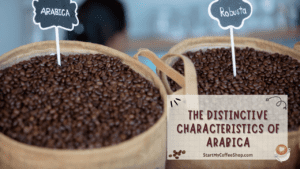Coffee is one of the most beloved and extensively consumed beverages in the world, renowned for its energizing and flavorful properties. From its origins in antiquity to the present day, coffee has developed a wide variety of flavor profiles, attributable to the various coffee bean varieties and growing regions.
The best way to appreciate coffee’s diverse flavors is to explore its main types, such as Arabica, with mild, aromatic notes grown at higher altitudes in Latin America, Africa, and Asia, and Robusta, strong and bitter, with higher caffeine content, grown at lower altitudes in Africa and Southeast Asia.
In this article, we delve into the world of coffee appreciation, examining its flavors and characteristics and uncovering that the best way to appreciate coffee’s diverse flavors is to embrace its main varieties.
The Distinctive Characteristics of Arabica

The most popular and commonly used variety of coffee beans is Arabica, scientifically known as Coffea arabica, which accounts for an astounding 60–70% of global coffee production. Arabica plants thrive at higher elevations, usually over 2,000 feet, in climates with lower temperatures and clearly defined wet and dry seasons. The combination of these particular growing circumstances acts like an alchemist, shaping the development of coffee cherries and ultimately giving rise to the gentle, aromatic notes that have made Arabica beans famous around the world.
Arabica coffee is renowned and enjoyed for its complex flavor profile, which stands as a symphony of subtle and nuanced notes. Arabica, which is sometimes described as having a smoother and more refined flavor, reveals a symphony of sensations that seduce the discriminating palate. It tempts with sweeter undertones that are well blended with undertones of fragrant flowers. These undertones are reminiscent of ripe fruit, mixed berries, and delectable nuts. Connoisseurs and coffee lovers alike are invited to set off on a journey of sensory discovery and appreciation through this complex combination of tastes.
Arabica is a delight for people who enjoy the art of coffee tasting because it reveals layers of complexity and depth, much like the brushstrokes of a skilled painter on a canvas. With each taste, this treasured coffee bean shows a different side of its personality, leaving an everlasting imprint on the palate and inspiring a strong, unyielding love for it.
Arabica beans are grown in a variety of places around the world, with Latin America, Africa, and Asia producing the majority of the crop. Each area adds to the coffee’s complex personality with its distinctive soil composition, various climate patterns, and varied altitudes. These elements endow Arabica beans with their distinctive flavor profiles, making each harvest a unique experience.
Some of the best Arabica beans are produced in the core of Latin America, in nations like Colombia, Brazil, Costa Rica, and Ethiopia. Colombian coffee is praised for its pleasant fruity aromas that dance on the tongue and its wonderfully balanced acidity. The taste of Brazilian Arabica beans, in contrast, envelops the palate with a nutty and chocolatey embrace and lingers like a warm, comfortable hug.
Arabica beans produce an unparalleled symphony of tastes in the enchanted lands of Ethiopia, the country that gave rise to coffee itself. These flavors range from lemony and floral to wine-like and intensely fruity. These beans are valued as gems of cultural identity and heritage in Ethiopian coffee culture, which is entrenched in centuries-old traditions.
Arabica beans grow in abundance in the Kenyan highlands, bringing the beautiful African continent’s coffee a delectable acidity that is balanced by fruity, wine-like overtones. Tanzanian Arabica beans, on the other hand, exhibit a more laid-back personality and entice coffee lovers to investigate a softer and more harmonious flavor profile.
Arabica beans from places like Indonesia and Papua New Guinea embrace distinctive qualities as one travels through the vast plains of Asian coffee estates. Indonesian Arabica beans have a delicious range of aromas that entice the palate, frequently leaning toward earthy, spicy, and even herbal undertones. The Arabica beans from Papua New Guinea, however, produce a captivating fusion of fruitiness and florals, as if the flavor of the island’s luscious rainforests were captured within each coffee bean.
Read more about: Short Business Plan for Coffee Shop: A Cup Full of Strategy
The Bold Characteristics of Robusta
Coffea canephora, the scientific name for Robusta coffee, accounts for 30–40% of global coffee production. It differs from Arabica due to its strong nature and higher caffeine level. Robusta beans thrive in lower altitudes and warmer climes, making them a good choice for places with consistent temperatures and rainfall. Because of its natural toughness, Robusta is a popular variety for growing coffee all around the world, giving drinkers a distinctively robust and invigorating experience with every sip.
- Flavor Profile: The flavor characteristic of robusta coffee distinguishes it from its milder relative, arabica. Robusta has a bold and robust character that coffee connoisseurs enjoy for its uniqueness while displaying a strong and full-bodied flavor. For those who like a stronger cup of coffee, the increased bitterness of Robusta imparts a bolder and more powerful flavor experience.
The earthy essence of the Robusta flavor, which gives each sip depth and richness, is one of its distinguishing characteristics. This distinctive quality is frequently matched by nutty overtones, creating a pleasant flavor interaction that lingers on the palate. Robusta beans may exhibit woody overtones, adding a level of depth to the overall flavor profile.
Due to their inherent robustness, Robusta beans are frequently used in espresso blends, where they considerably increase the crema’s richness. The presence of Robusta, which adds a delectable taste punch and satisfies the needs of coffee fans seeking a more robust coffee experience, is largely responsible for the espresso’s bold and velvety texture.
- Growing Regions: Robusta thrives as a hardy and essential component of diverse coffee blends, mostly in the lush regions of Southeast Asia and Africa. Robusta is the best variety for coffee growing in various areas of the world because of the equatorial climates that these areas offer, which give the variety the stable temperatures and plentiful rainfall that it needs.
African nations like Uganda, Tanzania, and the Ivory Coast are well known for their superior Robusta bean production. African farmers cultivate coffee plants that produce robust and bold beans that are prized for their distinctive flavors by embracing the rich soils and good climatic circumstances.
Vietnam and Indonesia stand out as significant Robusta cultivators in Southeast Asia. In areas where Arabica would struggle to develop due to lower altitudes and less tolerant climatic patterns, Robusta’s resilience is useful.
Many coffee farmers in these areas rely on the production of Robusta because it offers a crop that is resistant to pests and illnesses as well as a more steady and consistent source of income. Robusta is frequently used to produce instant coffee due to its greater caffeine concentration, which adds to its economic importance in these coffee-growing regions.
Exploring Flavor Variation based on Region and Processing
Millions of people throughout the world enjoy coffee, which has a wide range of flavor profiles thanks to a variety of elements that go beyond the simple classification of Arabica and Robusta beans. While Robusta takes root at lower heights and has a bolder, more bitter flavor, Arabica is prized for its delicate and nuanced characteristics and is grown at higher altitudes in places like Ethiopia or Colombia. The origin and processing of these beans also have a significant impact on how the final cup is made, adding to the fascinating variety of flavors.
Each place that produces coffee boasts unique environmental traits, such as climate, soil type, and altitude, which have a big impact on the flavor of the beans. In contrast, Colombian coffee surprises with a combination of sweetness and acidity, nourished in the high Andes highlands, while Ethiopian coffee frequently displays fruity and flowery aromas, an homage to its home soil and altitude.
Processing techniques have a big impact. The two main methods, washed and natural, give the beans different flavors. To dry the seeds for washed coffee, which is popular in places like Central America, the fruit’s outer layers must be removed. As a result, flavors are purer, brighter, and lighter in the body. Contrarily, natural processing, which is popular in Brazil and other nations, enables the beans to dry inside the fruit, imparting a strong fruitiness and rich, full-bodied flavor.
Regional Variations
- Latin American Arabica: Arabica Coffee from Latin America Countries such as Colombia, Brazil, Costa Rica, and Ethiopia are making their mark on the global coffee scene with their high-quality Arabica coffee, and the Latin American continent is known as a treasure trove of Arabica coffee. Arabica beans from Colombia, which are famous for the perfect balance of acidity and fruitiness that they possess, provide a delectable symphony of flavors that mesmerize the palette. On the other hand, Brazilian Arabica beans fascinate coffee lovers with their captivating nutty and chocolatey undertones, resulting in a coffee experience that is both reassuring and delicious.
- Costa Rican Arabica: These beans from Costa Rica are known for their energizing brightness as well as their appealing floral aroma, which lends a touch of sophistication to every cup. Ethiopia, the country that is considered to be the home of coffee, produces Arabica beans that have an unrivaled level of flavor complexity. These beans have aromas and flavors that range from citrusy and flowery to wine-like and fruity overtones. Coffee enthusiasts are invited to embark on an adventure of discovery around the globe of coffee’s most recognized variety by trying each of these Latin American Arabica offers. Each of these Latin American Arabica offerings highlights the distinct terroir and precise workmanship of the region.
- African Robusta: Robusta beans from Uganda and Tanzania are the stars of the show when it comes to the Robusta variety of coffee produced in Africa. The continent of Africa is home to wide and beautiful landscapes. The flavor profile of Ugandan Robusta coffee is very smooth and mellow, which is a very appealing quality that makes it very approachable and pleasurable to drink. This coffee is a delight to the palate. The taste trip of Tanzanian Robusta, on the other hand, leads to a destination that is more robust and earthy, where the coffee’s strength creates a long-lasting imprint.
These geographical differences in African Robusta beans are a tribute to the many coffee terroirs and agricultural practices that can be found across the African continent. Coffee connoisseurs will have the opportunity to enjoy the depth of African coffee craftsmanship when they purchase Robusta beans from Uganda and Tanzania since these countries’ Robusta beans have been endowed with distinctive qualities because of their lush forests and fertile soils.
Processing Methods

- Wet Processed Coffee: The skill of wet processing, which is also known as washed coffee, finds its expertise in countries such as Ethiopia and Central America, where Arabica beans are pampered to the point where they are ideal. Before allowing the coffee beans to dry, this laborious process requires the removal of the outer skin as well as the pulp of the coffee cherry. Wet processing results in a cup of coffee that is clear and lively, highlighting the flavors that are already present in the Arabica bean without adding any other elements. The end product is a beautifully well-balanced brew, which enables the delicate flavor notes of the coffee to show through and captivate the senses.
- Dry Processed Coffee: Dry processing, which is revered as the purest form of coffee, is the method of choice in nations like Vietnam and Brazil, which have a thriving Robusta bean industry. By this time-honored practice, the coffee cherries are removed before the coffee beans are allowed to undergo the drying process inside the fruit. A fruit-forward and sweet flavor profile with a fuller body is produced as a result of the sun’s gentle caress, which coaxes the sugars from the fruit and infuses them into the beans. This method of processing allows coffee lovers the opportunity to appreciate the bold and naturally sweet essence of Robusta coffee, which is characterized by its innate robustness and flavor complexity, which find a delightful expression in this method.
Read more about: Simple Business Plan Coffee Shop: Leveling Up Your Coffee Shop Dream
Frequently Asked Questions

Which characteristics of Arabica and Robusta coffee beans are the most distinctive?
The two most popular varieties of coffee beans are Arabica and Robusta. Arabica is cultivated at higher altitudes in Latin America, Africa, and Asia and is renowned for its delicate, aromatic aromas. Robusta, on the other hand, is often grown at lower altitudes in Africa and Southeast Asia and is robust, bitter, and contains more caffeine.
How does the coffee’s flavor differ depending on the growing area?
The flavor of coffee is greatly influenced by the growing region. Different soil types, climatic conditions, and elevations are found in many regions, including Latin America, Africa, and Asia, which all have an impact on the flavor of the coffee. While African Robusta could have a smoother, more mellow flavor, Latin American Arabica frequently displays balanced acidity and fruity undertones.
What are the various coffee processing techniques, and how do they impact flavor?
Wet processing (washed) and dry processing (natural) are the two primary coffee processing techniques. Arabica beans are frequently processed wet, which produces cleaner, brighter cups by eliminating the cherry peel and pulp before drying. Robusta beans are frequently processed using the dry method, which includes drying the cherries whole. This gives the beans more fruity, sweet flavors and a fuller body. The wide variety of coffee flavors available to enthusiasts is a result of these techniques.
To learn more on how to start your own coffee shop, check out my startup documents here.
Disclaimer: The information provided by StartMyCoffeeShop.com (“The Site”) is for general informational purposes only. All information on the Site is provided in good faith. However, we make no representation or warranty of any kind, express or implied, regarding the accuracy, adequacy, validity, reliability, availability, or completeness of any information on the Site. Under no circumstance shall we have any liability to you for any loss or damage of any kind incurred as a result of the use of the Site or Reliance on any information provided on the Site. Your use of the Site and reliance on any information on the Site is solely at your own risk. This blog post is for educational purposes only and does not constitute legal advice. Please consult a legal expert to address your specific needs. Terms and Conditions. (https://startmycoffeeshop.com/terms-and-conditions/)

Hi! I’m Shawn Chun
My adventure in coffee began when I first launched my first coffee shop back in the early 2000s. I had to figure out so many things on my own and to make it worse within 2 years of opening two large corporate coffee chains moved in just blocks away from me!
As I saw smaller and even some larger coffee shops in the neighborhood slowly lose customers to these giant coffee chains and slowly close up shop, I knew that I had to start getting creative…or go out of business.
I (like you may be) knew the coffee industry well. I could make the best latte art around and the foam on my caps was the fluffiest you have ever seen. I even had the best state-of-the-art 2 group digital Nuova Simonelli machine money could buy. But I knew that these things alone would not be enough to lure customers away from the name brand established coffee shops.
Eventually, through lots of trial and error as well as perseverance and creativity I did find a way to not only survive but also thrive in the coffee/espresso industry even while those corporate coffee chains stayed put. During those years I learned to adapt and always faced new challenges. It was not always easy, however, in the end, I was the sole survivor independent coffee shop within a 10-mile radius of my location. Just two corporate coffee chains and I were left after that year. All told the corporate coffee chains took down over 15 small independent coffee shops and kiosks and I was the last one standing and thriving.
Along the years I meet others with the same passion for coffee and I quickly learned that it is not only “how good a barista is” that makes a coffee shop successful, but the business side of coffee as well.
Hence why I started this website you are on now. To provide the tools and resources for up and coming coffee shop owners to gain that vital insight and knowledge on how to start a coffee shop successfully.
Stick around, browse through my helpful blog and resources and enjoy your stay! With lots of LATTE LOVE!
Shawn







